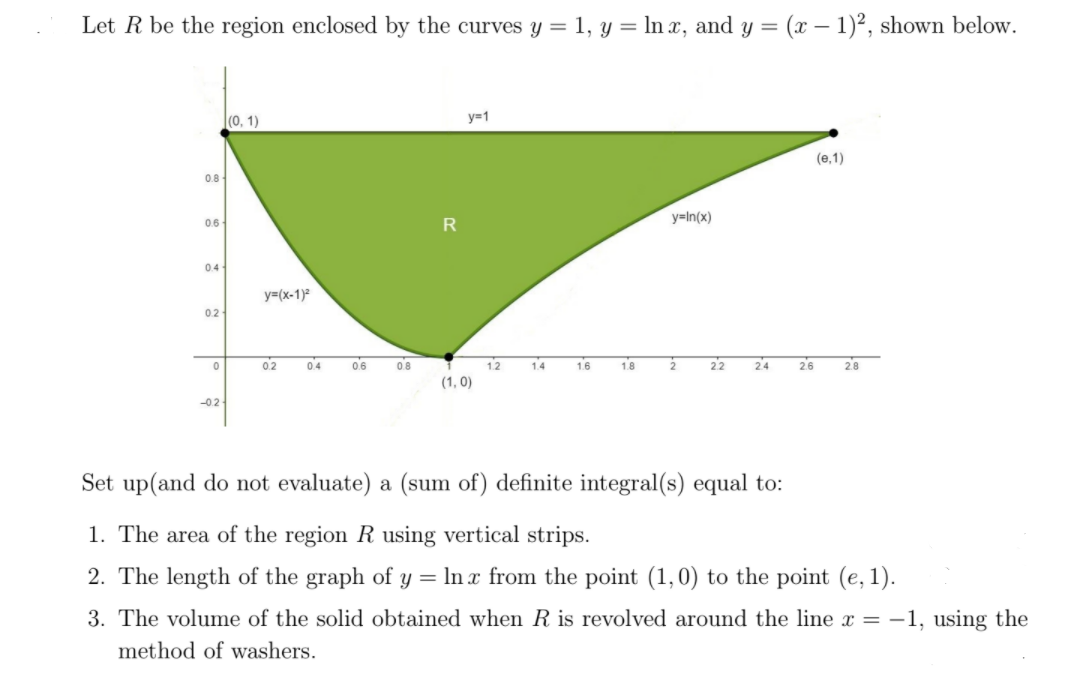Let R be the region enclosed by the curves y = 1, y = ln x, and y = (x – 1)², shown below. (0, 1) y=1 (e,1) 0.8 y=In(x) 0.6 R 04 y=(x-1) 02 12 (1, 0) 02 0.4 0.6 08 1.4 1.6 1.8 22 24 26 28 -02 Set up(and do not evaluate) a (sum of) definite integral(s) equal to: 1. The area of the region R using vertical strips. 2. The length of the graph of y = In x from the point (1,0) to the point (e, 1). 3. The volume of the solid obtained when R is revolved around the line x = -1, using the method of washers.
Let R be the region enclosed by the curves y = 1, y = ln x, and y = (x – 1)², shown below. (0, 1) y=1 (e,1) 0.8 y=In(x) 0.6 R 04 y=(x-1) 02 12 (1, 0) 02 0.4 0.6 08 1.4 1.6 1.8 22 24 26 28 -02 Set up(and do not evaluate) a (sum of) definite integral(s) equal to: 1. The area of the region R using vertical strips. 2. The length of the graph of y = In x from the point (1,0) to the point (e, 1). 3. The volume of the solid obtained when R is revolved around the line x = -1, using the method of washers.
Algebra & Trigonometry with Analytic Geometry
13th Edition
ISBN:9781133382119
Author:Swokowski
Publisher:Swokowski
Chapter9: Systems Of Equations And Inequalities
Section: Chapter Questions
Problem 12T
Related questions
Question
Solution for #3.
Set up(and do not evaluate) a (sum of) definite integral(s) equal to the volume of the solid obtained when R is revolved around the line x = −1, using the method of washers.

Transcribed Image Text:Let R be the region enclosed by the curves y = 1, y = ln x, and y = (x – 1)², shown below.
(0, 1)
y=1
(e,1)
0.8
y=In(x)
0.6
R
04
y=(x-1)
0.2
12
(1, 0)
0.2
0.4
0.6
08
1.4
1.6
1.8
22
24
26
2.8
--02
Set up(and do not evaluate) a (sum of) definite integral(s) equal to:
1. The area of the region R using vertical strips.
2. The length of the graph of y = In x from the point (1,0) to the point (e, 1).
3. The volume of the solid obtained when R is revolved around the line x = -1, using the
method of washers.
Expert Solution
This question has been solved!
Explore an expertly crafted, step-by-step solution for a thorough understanding of key concepts.
This is a popular solution!
Trending now
This is a popular solution!
Step by step
Solved in 2 steps with 2 images

Recommended textbooks for you

Algebra & Trigonometry with Analytic Geometry
Algebra
ISBN:
9781133382119
Author:
Swokowski
Publisher:
Cengage

Algebra & Trigonometry with Analytic Geometry
Algebra
ISBN:
9781133382119
Author:
Swokowski
Publisher:
Cengage